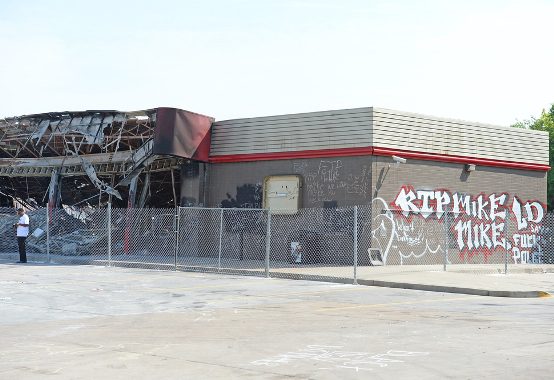Ferguson: We Can’t Look Away

It’s time once again to bring out the well-worn quote (from Marx) that history repeats itself, “first as tragedy, then as farce.” No one in my home could take their eyes off the television Monday evening, though all that was on was Jake Tapper marching around Ferguson, Missouri tracking down rumors of fresh violence. It all seemed so scripted. The outside world may be blowing up—major crises in Ukraine, the Mideast, and the South China Sea—which if escalated and spread could bring the world to the brink of global war. But we couldn’t turn away from the rinky-dink St. Louis suburb. Outside agitators—were there not such people, one would be want to put this ’60s era retro-phrase in quotation marks—have purportedly come to Ferguson from as far as New York and California.
There was real tragedy in the first round of American inner city riots—provoked in most cases by genuine police brutality. In 1967, the New York Review of Books ran Tom Hayden’s lengthy depiction of the riot there. Hayden, then a well known New Left figure, knew Newark, had been an anti-poverty organizer there. His sympathies were obvious, but Hayden is no fool, and I’m sure most of the facts are correct. One thing which stands out in those days was the way in which law and order views were expressed in forms indistinguishable from race baiting. Can one imagine the Democratic governor of a major state today saying, as New Jersey governor Richard Hughes did, before calling out the National Guard, “The line between the jungle and the law might as well be drawn here as any place in America.” Hughes, recall, was not George Wallace but a major progressive figure.
The costs of the insurrection to Newark were brutal. In Hayden’s summary
In the carrying out of the Governor’s weekend definitions and policies at least twenty Negroes died, nearly all from police shooting, another 1000 were injured and 1000 jailed; more than 100 Negro-owned businesses were attacked by police and troopers; and hundreds of apartments were fired into along the ghetto’s streets.
The outcomes were comparable in Detroit, in both cities the riots sparking an exodus of white population, with its skills and capital. New York, in great part due to the personal courage of John Lindsay, avoided the hot summer. The riots spurred a major national effort to integrate urban police forces, an effort which evidently bypassed the suburb Ferguson.
In those days the precipitating incidents were, in ways that the Ferguson killing does not seem to be, clear cut cases of racist police brutality. No one who saw the video of Michael Brown robbing a convenience store will think it out of the question that the police officer who shot him 15 minutes later feared genuinely for his life. Of course the shooting should not have happened: police officers have to be able to make arrests without using deadly force—and if they can’t, they should in most cases give way—as Brown’s shooter must surely feel today. But it can’t be easy in the heat of confrontation—just as most highly skilled professionals will make errors under duress, so will an average cop.
To read Hayden’s account is to be reminded that though history may in some ways repeat itself, in America race relations are much better, and feel very different. It was reasonable to believe, or at least many did, in the 1960s that America’s very future depended upon solving the problems of racial inequality; and it was quite possible 25 years later to feel that growing crime and disorder threatened the very viability of urban life in America. (This is what the editorial page of the early 1990s New York Post, where I was an editor, believed quite passionately.) But seemingly intractable problems, even if not solved, get diminished. Or transformed. Growing inequality in America is more severe now than in the 1990s and affects poor and working class whites as much as blacks. Whether or not this constitutes improvement is not obvious.
The Ferguson stand-off seems artificial, even theatrical, in comparison to the showdowns of the 1990s, much less the 1960s. The Ferguson police have presented themselves as an occupying army, complete with tanks, machine guns, and body armor. In Los Angeles, in 1992, the police let the crowd riot till the anger burned out. That choice would probably turn out better for all concerned. In the meantime the perennial question of how forceful police can be in the face of perceived threats to public order will smolder on. It’s just less urgent than it once was. As Ross Douthat argues cogently in the Times, law and order concerns are less dominant when crime rates hover near 20-year lows than when they have been spiking for years. Nevertheless if Molotov cocktails are being thrown in middle America, America’s TVs will be on, and people will be watching.
Comments